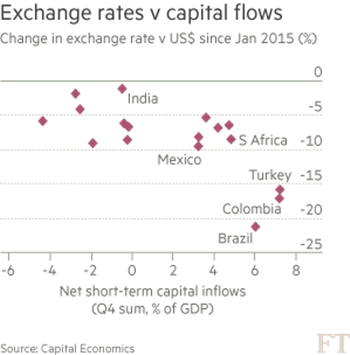(单词翻译:单击)

There are no atheists in foxholes; is there any differentiation in an emerging market meltdown? Emerging market policymakers have had their strenuous efforts to reduce vulnerability stress-tested to the extreme by the market panic this week.
散兵坑里没有无神论者;新兴市场在崩溃中会有任何分化吗?新兴市场政策制定者已下了很大的努力来降低本国的脆弱性。这种脆弱性在上周的市场恐慌中遭到极端的压力测试。
There have been myriad attempts to sort EMs into different categories susceptible to different shocks, the most recent being the Morgan Stanley typology reproduced here. But the history of previous episodes of market turmoil, most particularly the taper tantrums of last year and early this year, is that all EMs can get drawn into the maelstrom.
人们已很多次尝试把新兴市场区分为易受不同冲击的不同类别,比如最近重新被运用的摩根士丹利(Morgan Stanley)分类法。但是,以往多次市场混乱、尤其是去年和今年初的“缩减恐慌”(taper tantrum,即美联储缩减量化宽松引起的恐慌),表明所有新兴市场都可能被拉入大漩涡中。
It is obviously way too soon to draw firm conclusions about how much EM assets will all suffer together from the latest asset price turmoil — not least because the People’s Bank of China stepping in with a rate cut on Tuesday helped to reverse some of the falls. But the history of previous episodes of emerging market turmoil, plus some tentative signs in recent months and days, suggest that EMs that have done their policy groundwork may be rewarded.
对于最近这次资产价格混乱将对新兴市场资产总共产生多大影响,要想得出确切结论显然还为时尚早,尤其是8月25日中国央行(PBoC)通过降息施加干预,在一定程度上帮助扭转了下跌趋势。但新兴市场之前的几次动荡以及最近的初步迹象都显示出,那些打好了政策基础的新兴市场或许能得到回报。
In the Asian and Russian crisis in 1997-1998, investors picked off countries one by one by shorting their currencies without differentiating much on the basis of their various current account and debt positions. It was (and is) an issue of lingering resentment in South Korea that first investors (and then the International Monetary Fund in its rescue lending) treated a currency mismatch as though it had been a full-blown solvency crisis. Before the crisis, Korea had a budget that was forecast to be in surplus, low internal and external sovereign debt relative to GDP, a narrowing current account deficit and a fairly-valued or undervalued exchange rate. Nonetheless, pressure on its currency because of borrowing abroad by its banks forced it into the arms of the IMF.
在1997年至1998年的亚洲与俄罗斯危机中,投资者对新兴市场国家不同的经常账户和债务状况几乎不加区分,一律做空它们的货币,逐个打垮了它们。韩国曾经(现在依然)对一个问题怨恨不已,那就是,先是投资者、后是提供救助贷款的国际货币基金组织(IMF)把一次货币错配当成一场全面偿付能力危机来对待。危机之前,韩国本来预计会有预算盈余、较低的对内和对外主权债务与国内生产总值(GDP)之比、缩小的经常账户赤字以及估值公允或低估的汇率。然而,韩国的银行在国外借入资金对本国货币造成压力,迫使韩国任由IMF摆布。
During the global financial crisis of 2008-2009, however, EMs were in general much better prepared and investors showed themselves more willing to discriminate. Even traditionally crisis-prone countries like Brazil came through reasonably well as long as they were in moderately good economic shape (in Brazil’s case, those were the days) and had built up large foreign exchange reserves. Unlike the Asian crisis, where a series of pegged currencies could be attacked, there was no one obvious way in which all EMs were vulnerable.
但在2008年至2009年的全球金融危机中,新兴市场总体上准备充分得多,投资者也表现得更愿意对它们进行区分。甚至连巴西等在传统上容易爆发危机的国家也相当不错地挺了过来,只要它们的经济处于适度良好的状况(巴西今不如昔了)并且积累了高额外汇储备。在之前的亚洲危机中,一系列挂钩美元的货币都可能成为攻击对象,与此不同,在全球金融危机中,没有哪个明显因素让所有新兴国家都显出脆弱性。
And with the crisis being essentially one of the rich world, investors proved themselves capable of distinguishing those EMs with very direct exposure and those that did not. The Baltic states, pegged to the euro and with strong banking links to the eurozone countries, came under much more pressure than even neighbouring economies like Poland with its independent currency and a low debt to GDP ratio.
全球金融危机主要是富国的危机,而投资者证明了自己能够区分有直接风险敞口和没有直接风险敞口的新兴市场。与欧元挂钩、银行业与欧元区联系紧密的波罗的海各国,遭受的压力甚至比拥有自己的货币、债务与GDP之比很低的波兰等临近欧元区的国家要大得多。
More recent evidence is tentatively positive for the differentiators. During the falls in EM currencies before the PBoC disrupted markets by depreciating the renminbi this month, there was some evidence of discrimination based on fundamentals. Currencies performed better against the dollar if their economies were less dependent on short-term capital inflows. The Indian rupee in particular appeared to benefit from the strengthening of the country’s macroeconomic framework, falling by much less than other EM Asian currencies including the rupiah and ringgit, let alone problem children like the Brazilian real and Turkish lira.
最近的证据暂时有利于区分者。在8月中国央行贬值人民币引发市场动荡之前的新兴市场货币下跌中,一些证据显示出经济基本面带来的分化。如果某些新兴市场经济体对短期资本流入的依赖程度更低,则其货币对美元的表现就会更好。特别是印度卢比,似乎受益于本国宏观经济框架的加强,下跌幅度比印尼盾和马来西亚林吉特等其他亚洲新兴市场货币小得多,相比巴西雷亚尔和土耳其里拉等“问题小孩”就更不必说了。
And even in the turmoil created by the PBoC allowing the renminbi to fall last week and then cutting interest rates on Tuesday, currencies in well-run central and eastern European countries — which have small direct links to China and relatively good fundamentals — have held up pretty well. In contrast to the sharp falls in the Turkish lira and rouble, the Czech koruna, Hungarian forint and Romanian leu have held on to most of their gains against the euro since mid-year and have risen against the dollar. Central and eastern European equities have fallen along with stock prices elsewhere in EM, but are still well up on the year to date.
甚至在中国央行允许人民币下跌、然后降息引发的混乱中,管理良好的中欧和东欧国家(它们与中国的直接联系很小并且基本面相对较好)的货币都表现得很坚挺。跟土耳其里拉和俄罗斯卢布的大幅下跌形成对照的是,捷克克朗、匈牙利福林和罗马尼亚列伊都保住了自年中以来对欧元的大部分涨幅,并对美元有所升值。中欧和东欧股市已跟随所有其他新兴市场股市一起下跌,但今年迄今的涨幅仍很高。
And — although this is getting into the realm of micro-evidence — trading on Monday before the PBoC cut interest rates suggested investors were prepared to distinguish between China and the rest. EM equities across Asia recovered from their falls of the previous week, while Chinese stocks continued to slide.
同时——尽管这开始进入微观证据的范畴——中国央行降息之前的周一的交易表明,投资者准备把中国和其他新兴市场区分开来。整个亚洲的新兴市场股市收复了前一周的失地,而中国股市继续下跌。
In the longer term, the actual impact on EM economies from recent market turbulence will not necessarily match the price movements. Commodity exporters with strong inflation and crisis-fighting credentials are likely to benefit rather than lose from depreciations.
从更长远看,近期市场动荡对新兴市场的实际影响将不一定与价格变动一致。通胀水平高、应对危机能力强的大宗商品出口国,可能从贬值中受益而不是受损。
The impact of stock price movements on the real economy depends on how exposed households are to equity markets — a point many observers have made with respect to China — and how dependent companies are on them to raise capital. (It is notable that EM bond prices have often moved less in recent weeks than currencies and stocks.)
股价波动对实体经济的影响,取决于家庭在股市投入了多少——许多观察人士在研究中国时得出了这个结论——以及企业在多大程度上依赖股市筹集资本。(值得注意的是,近几周里,新兴市场债券价格的波动经常小于其汇率和股市的波动。)
Just as worrying to EMs as market turbulence should be the fact that, when investors come looking for good stories in periods of calm, they will find all too few.
对新兴市场而言,与市场动荡同样令人担心的应该是如下事实:当投资者在市场平静期寻找好题材时,他们将很难找到。
Even in the recent turbulence of the markets, there have been some signs that investors are distinguishing within the increasingly dissimilar EM world. This may not survive a true meltdown, but the initial signs are that superior economic fundamentals and policymaking credibility are gaining some reward.
甚至在近来的市场动荡里,已有一些迹象表明,投资者开始对日益分化的新兴市场进行区分。这么做在一场真正的危机中或许不管用,但初步迹象显示,拥有更好经济基本面和政策信誉的新兴市场,正开始取得一些回报。


